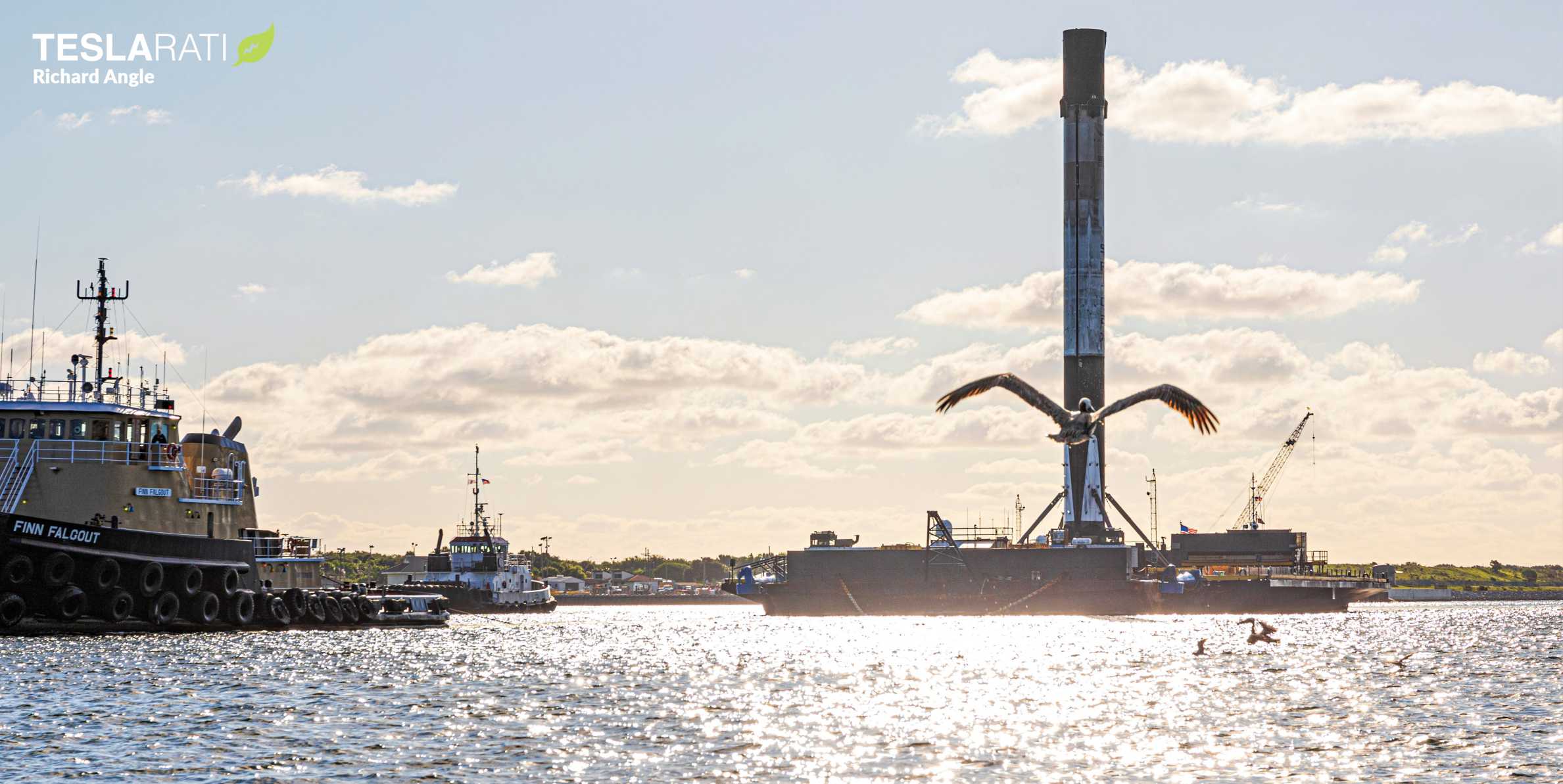

News
SpaceX’s rocket reusability dream is within reach after fastest recovery yet
SpaceX and CEO Elon Musk’s rocket reusability dream appears to be within reach for the first time ever after technicians managed to retract the most recently-launched Falcon 9 booster’s landing legs and bring it horizontal in record time.
On the heels of a SpaceX’s second orbital-class Falcon 9 launch, landing, and recovery just this month, the recovery milestone could mean that booster B1059 is being prepared for the fastest turnaround in the company’s history. Together, with two Starlink launches now complete less than two weeks into June 2020 and a third internet satellite mission scheduled as early as June 22nd, the odds are better than ever that SpaceX will be able to pull off a record launch cadence heading into the second half of the year.

Averaged out, a sustained frequency of one launch every ~7 days would give SpaceX the ability to perform more than 50 orbital launches annually. In fact, just earlier this year, an environmental impact assessment completed for upgrades at Kennedy Space Center (KSC) Pad 39A revealed plans for as many as 70 annual launches from SpaceX’s two Florida pads by 2023.
Technically, SpaceX has already demonstrated that those two Florida launch pads – KSC Pad 39A and Cape Canaveral Air Force Station (CCAFS) LC-40 – are able to support 60-70 annual launches when pushed to their limits, with the latter pad recently performing two launches in just nine days for a potential maximum of 40 launches in one year. If SpaceX can pull off four Falcon 9 launches in 27 days, as it’s currently scheduled to do, the company will have already come a majority (75%) of the way to demonstrating that its fleet of Falcon rockets is also up to the task.
Currently the newest flown booster in SpaceX’s Falcon 9 fleet, the company has also wasted no time processing B1059 after ~8 am EDT return to Port Canaveral, kicking off landing leg retraction scarcely eight hours after berthing. B1059’s first sea recovery was also the second use of drone ship Of Course I Still Love You’s (OCISLY) upgraded Octagrabber, a tank-like robot used to keep technicians safe while remotely securing Falcon boosters on the high seas.
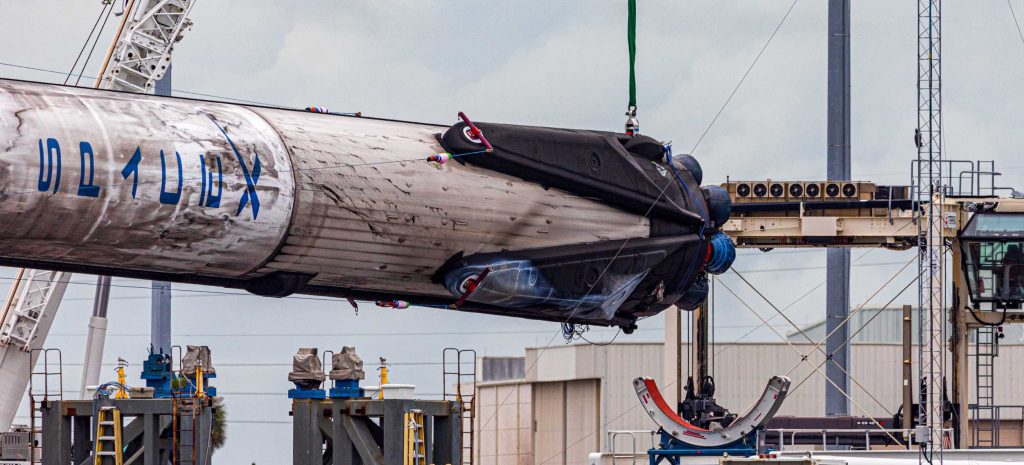
Octagrabber 2.0
By all appearances, SpaceX is using a new recovery method debuted with Falcon 9 booster B1058 earlier this month for the second time. With that significant operational tweak, the company no longer has to crane Falcon 9 boosters off of the drone ship before it can begin landing leg retraction – itself a process that’s barely a year old. By entirely supporting a booster with an upgraded Octagrabber robot and retracting its legs in situ, SpaceX can completely skip a recovery processing step, only lifting the rocket once it’s ready to be broken over (brought horizontal) and loaded onto a transporter.
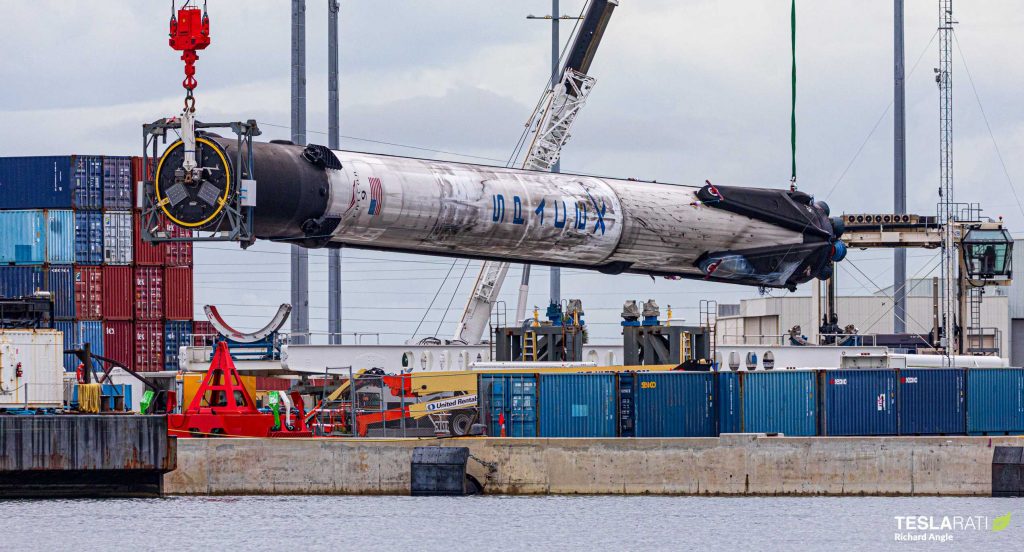
Unsurprisingly, on its first use, the improved efficiency allowed SpaceX to process a booster faster than any before it, breaking the previous record of ~1.9 days from port arrival to departure on a horizontal transporter. Now, B1059 is already on pace to beat B1058’s weeks-old recovery turnaround record. Extra-efficient recovery processing and the unprecedentedly rapid booster reuse it could soon enable will be crucial if SpaceX hopes to sustain a cadence of 3-6 Falcon 9 launches per month over the next few years.
Such a cadence is a necessity for the expedient deployment of the 12,000 to 40,000-satellite Starlink internet constellation. With SpaceX all but guaranteed to demonstrate three Starlink launches in a single month (in fact, less than three weeks), the company is making rapid progress in the right direction.
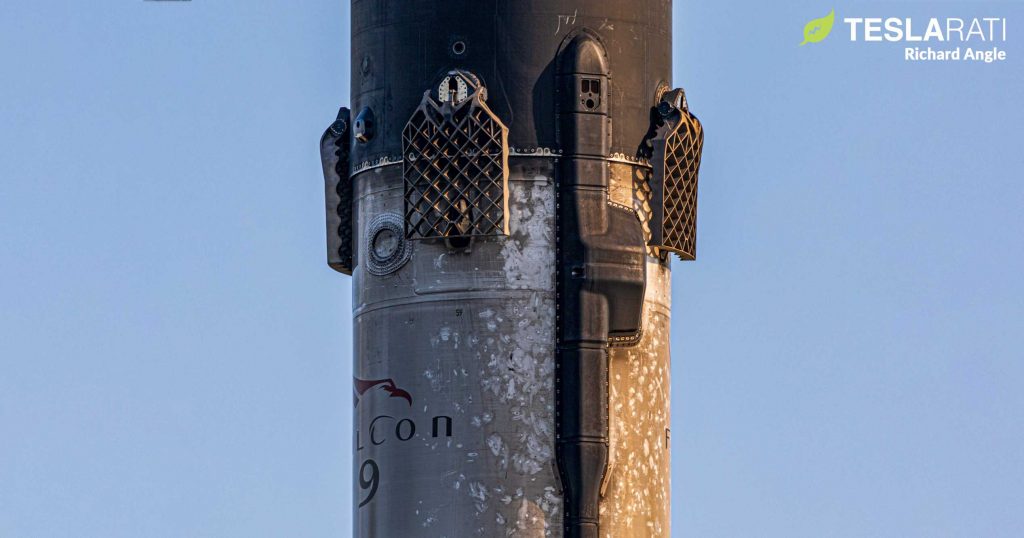
Speeding through recovery
In fact, as of writing, Falcon 9 B1059 has already had all four landing legs retracted and was lifted off drone ship OCISLY, broken over, and placed on SpaceX’s custom booster transporter less than 10 hours after it arrived in port. A step further, SpaceX took an incredible 8-9 hours after docking to bring the booster horizontal, crushing the previous record – ~27 hours – by a factor of three or more.
Given that unprecedented expediency, it wouldn’t be crazy to imagine that SpaceX could be aiming for a record-breaking booster turnaround on one of its next few Starlink launches, scheduled June 22nd and sometime in July. Held by the late booster B1056, SpaceX’s current turnaround record (the time between two launches) is 62 days, while the company and CEO Elon Musk’s ultimate reusability goal is to fly the same booster twice in just 24 hours.
Drone ship recoveries, of course, will almost always require at least a few extra days to travel back to port. Still, the fact that 99% of the processing needed to transport a booster can now be finished in as few as ~8 hours is the first unequivocal proof that a 24-hour turnaround is within SpaceX’s reach – so long as the rocket lands on land or the time in transit is excluded.

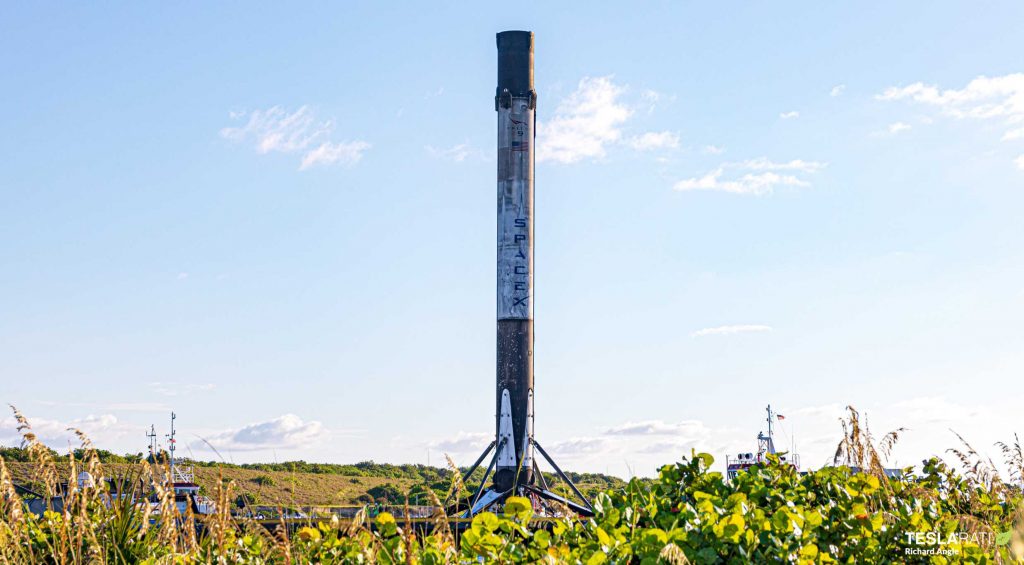


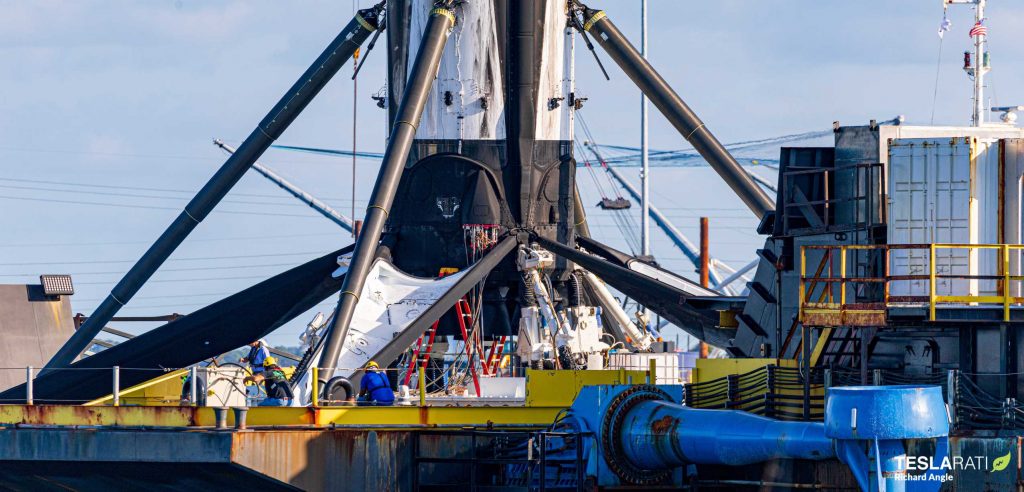
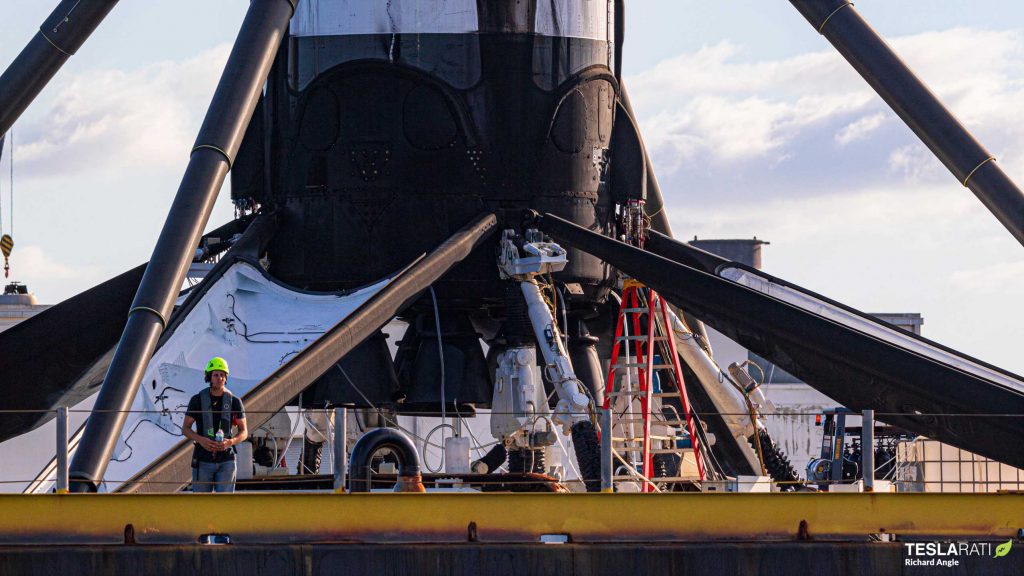
Check out Teslarati’s Marketplace! We offer Tesla accessories, including for the Tesla Cybertruck and Tesla Model 3.
Elon Musk
Why Tesla’s Q3 could be one of its biggest quarters in history
Tesla could stand to benefit from the removal of the $7,500 EV tax credit at the end of Q3.

Tesla has gotten off to a slow start in 2025, as the first half of the year has not been one to remember from a delivery perspective.
However, Q3 could end up being one of the best the company has had in history, with the United States potentially being a major contributor to what might reverse a slow start to the year.
Earlier today, the United States’ House of Representatives officially passed President Trump’s “Big Beautiful Bill,” after it made its way through the Senate earlier this week. The bill will head to President Trump, as he looks to sign it before his July 4 deadline.
The Bill will effectively bring closure to the $7,500 EV tax credit, which will end on September 30, 2025. This means, over the next three months in the United States, those who are looking to buy an EV will have their last chance to take advantage of the credit. EVs will then be, for most people, $7,500 more expensive, in essence.
The tax credit is available to any single filer who makes under $150,000 per year, $225,000 a year to a head of household, and $300,000 to couples filing jointly.
Ending the tax credit was expected with the Trump administration, as his policies have leaned significantly toward reliance on fossil fuels, ending what he calls an “EV mandate.” He has used this phrase several times in disagreements with Tesla CEO Elon Musk.
Nevertheless, those who have been on the fence about buying a Tesla, or any EV, for that matter, will have some decisions to make in the next three months. While all companies will stand to benefit from this time crunch, Tesla could be the true winner because of its sheer volume.
If things are done correctly, meaning if Tesla can also offer incentives like 0% APR, special pricing on leasing or financing, or other advantages (like free Red, White, and Blue for a short period of time in celebration of Independence Day), it could see some real volume in sales this quarter.
You can now buy a Tesla in Red, White, and Blue for free until July 14 https://t.co/iAwhaRFOH0
— TESLARATI (@Teslarati) July 3, 2025
Tesla is just a shade under 721,000 deliveries for the year, so it’s on pace for roughly 1.4 million for 2025. This would be a decrease from the 1.8 million cars it delivered in each of the last two years. Traditionally, the second half of the year has produced Tesla’s strongest quarters. Its top three quarters in terms of deliveries are Q4 2024 with 495,570 vehicles, Q4 2023 with 484,507 vehicles, and Q3 2024 with 462,890 vehicles.
Elon Musk
Tesla Full Self-Driving testing continues European expansion: here’s where
Tesla has launched Full Self-Driving testing in a fifth European country ahead of its launch.

Tesla Full Self-Driving is being tested in several countries across Europe as the company prepares to launch its driver assistance suite on the continent.
The company is still working through the regulatory hurdles with the European Union. They are plentiful and difficult to navigate, but Tesla is still making progress as its testing of FSD continues to expand.
Today, it officially began testing in a new country, as more regions open their doors to Tesla. Many owners and potential customers in Europe are awaiting its launch.
On Thursday, Tesla officially confirmed that Full Self-Driving testing is underway in Spain, as the company shared an extensive video of a trip through the streets of Madrid:
Como pez en el agua …
FSD Supervised testing in Madrid, Spain
Pending regulatory approval pic.twitter.com/txTgoWseuA
— Tesla Europe & Middle East (@teslaeurope) July 3, 2025
The launch of Full Self-Driving testing in Spain marks the fifth country in which Tesla has started assessing the suite’s performance in the European market.
Across the past several months, Tesla has been expanding the scope of countries where Full Self-Driving is being tested. It has already made it to Italy, France, the Netherlands, and Germany previously.
Tesla has already filed applications to have Full Self-Driving (Supervised) launched across the European Union, but CEO Elon Musk has indicated that this particular step has been the delay in the official launch of the suite thus far.
In mid-June, Musk revealed the frustrations Tesla has felt during its efforts to launch its Full Self-Driving (Supervised) suite in Europe, stating that the holdup can be attributed to authorities in various countries, as well as the EU as a whole:
Tesla Full Self-Driving’s European launch frustrations revealed by Elon Musk
“Waiting for Dutch authorities and then the EU to approve. Very frustrating and hurts the safety of people in Europe, as driving with advanced Autopilot on results in four times fewer injuries! Please ask your governing authorities to accelerate making Tesla safer in Europe.”
Waiting for Dutch authorities and then the EU to approve.
Very frustrating and hurts the safety of people in Europe, as driving with advanced Autopilot on results in four times fewer injuries!
Please ask your governing authorities to accelerate making Tesla safer in Europe. https://t.co/QIYCXhhaQp
— Elon Musk (@elonmusk) June 11, 2025
Tesla said last year that it planned to launch Full Self-Driving in Europe in 2025.
Elon Musk
xAI’s Memphis data center receives air permit despite community criticism
xAI welcomed the development in a post on its official xAI Memphis account on X.

Elon Musk’s artificial intelligence startup xAI has secured an air permit from Memphis health officials for its data center project, despite critics’ opposition and pending legal action. The Shelby County Health Department approved the permit this week, allowing xAI to operate 15 mobile gas turbines at its facility.
Air permit granted
The air permit comes after months of protests from Memphis residents and environmental justice advocates, who alleged that xAI violated the Clean Air Act by operating gas turbines without prior approval, as per a report from WIRED.
The Southern Environmental Law Center (SELC) and the NAACP has claimed that xAI installed dozens of gas turbines at its new data campus without acquiring the mandatory Prevention of Significant Deterioration (PSD) permit required for large-scale emission sources.
Local officials previously stated the turbines were considered “temporary” and thus not subject to stricter permitting. xAI applied for an air permit in January 2025, and in June, Memphis Mayor Paul Young acknowledged that the company was operating 21 turbines. SELC, however, has claimed that aerial footage shows the number may be as high as 35.
Critics are not giving up
Civil rights groups have stated that they intend to move forward with legal action. “xAI’s decision to install and operate dozens of polluting gas turbines without any permits or public oversight is a clear violation of the Clean Air Act,” said Patrick Anderson, senior attorney at SELC.
“Over the last year, these turbines have pumped out pollution that threatens the health of Memphis families. This notice paves the way for a lawsuit that can hold xAI accountable for its unlawful refusal to get permits for its gas turbines,” he added.
Sharon Wilson, a certified optical gas imaging thermographer, also described the emissions cloud in Memphis as notable. “I expected to see the typical power plant type of pollution that I see. What I saw was way worse than what I expected,” she said.
-

 Elon Musk3 days ago
Elon Musk3 days agoTesla investors will be shocked by Jim Cramer’s latest assessment
-

 News1 week ago
News1 week agoTesla Robotaxi’s biggest challenge seems to be this one thing
-

 News2 weeks ago
News2 weeks agoTexas lawmakers urge Tesla to delay Austin robotaxi launch to September
-

 Elon Musk2 weeks ago
Elon Musk2 weeks agoFirst Look at Tesla’s Robotaxi App: features, design, and more
-

 Elon Musk2 weeks ago
Elon Musk2 weeks agoxAI’s Grok 3 partners with Oracle Cloud for corporate AI innovation
-

 News2 weeks ago
News2 weeks agoWatch Tesla’s first driverless public Robotaxi rides in Texas
-

 News2 weeks ago
News2 weeks agoSpaceX and Elon Musk share insights on Starship Ship 36’s RUD
-

 News2 weeks ago
News2 weeks agoTesla has started rolling out initial round of Robotaxi invites

















